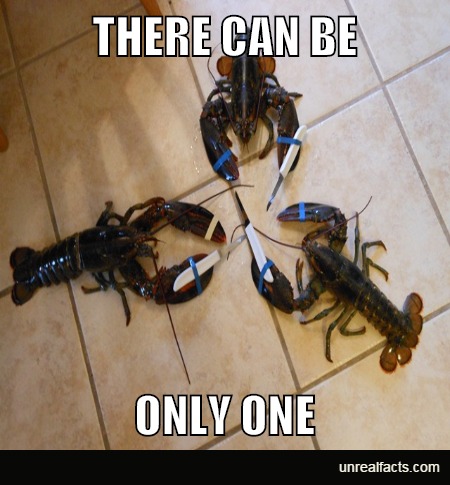
Have you heard the story that lobsters are immortal? I’m guessing that by now that there’s a very good chance that you have heard a brief rumor about their uncanny ability to cheat the rigors of old age. Well, how can I put this? Lobsters aren’t immortal. In fact, they don’t even come close to being immortal, and are just as prone to old age as any other animal on this planet.
Alright, I’ll admit it. The first time I heard this myth I instantly imagined hordes of lobsters roaming around carrying swords uttering “there can be only one,” all the while they cutting each others heads off in elegant displays of one on one combat with a blade. For the uninitiated among us it’s a reference to Highlander. This, I suppose, was the catalyst for me delving deeper to discover the truth behind the improbable chance that they could actually live forever.
This myth has been perpetuated, like many others before it, due to a slight misunderstanding. The misunderstanding originated from how a lobster grows. It sounds like an unlikely connection, but the dots were not really lined up correctly.
Lobsters grow continuously throughout their entire life. They eat, grow and molt, which means that they shed their hard shell (exoskeleton). When they are young they can molt up to 44 times in the first year of their life. As they age and grow, the molting process becomes less frequent. But they will continue to grow and molt. In fact, lobsters have no set size limit, and in theory could grow to the size of a grown adult if they had the time. This is where most people make the distinction that lobsters are immortal. Because they continue to grow forever people think that makes them immortal. But what they don’t realize is that they will stop molting eventually, and the process of molting is detrimental to the animal.
Imagine ripping your skin off and growing a new one. It doesn’t sound like it would be very comfortable or an easy process, does it? And just because a lobster does it, and has to just to survive, doesn’t mean that it is any easier. Each time they molt it becomes more difficult and requires more energy to complete the task. Many lobsters die each year just because the process is so taxing on them. But the test of old age is the biggest hurdle for them, and none can survive it.
As a lobster ages and nears their end, they will not be able to molt. This failure to molt is a tell-tale sign that the end is near. In short, they lack metabolic energy to carry out the task. The shell, which continues to become worn and damaged, will become infected with bacteria. This bacteria will eventually infect the lobster and kill them. Sometimes the bacteria will develop into a shell disease and form scar tissue. The scar tissue will bond the shell to the body of the lobster, and molting will become impossible. The shell will then rot on their body, killing the lobster in the process.
So while lobsters aren’t immortal there has not been any successful method for determining their age. Because there are no age rings, or other definitive ways to determine their age, an educated guess is the best that science can do at the moment. It has been suggested that female can live for an average of 54 years, and males for 31 years, which is far from being immortal.
SOURCES







